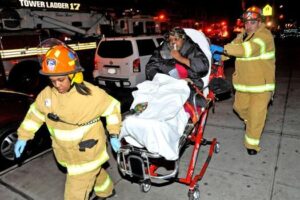Introduction
This post addresses your questions on fire related injuries.
Questions, you’ve got questions (Why are you so shy about posting them?). Here we go. Today, your focus is on the aftermath and treatment of fire related injury.
What does carbon monoxide poisoning look like?
- Carbon Monoxide (CO) poisoning is very dangerous because the gas is colorless and odorless. You should suspect that you’re feeling its effect when you’re feeling like you have the flu after perhaps being in a contained area with a motor running or after a fire. Headache is the most common symptom, and you may also feel nauseated, with malaise (feeling ‘blah’) and fatigue also being common symptoms.
How are burns from fire related injuries treated?
- Burns cause serious illness. The thermal component can cause direct damage to your airway. The toxins contained within (carbon monoxide and cyanide) can kill you independent of any other consideration. Burns are especially prone to infection, so you don’t want significant skin burns exposed to everything outside of a burnt house while you’re waiting for the ambulance.
- The burns will be treated according to the severity. A lot of intravenous fluid, pain management, clear blister removal and infection control will be in order. Especially serious burns may require a burn unit and skin grafting.
What can I do to treat while waiting for the ambulance?
- Keep calm, and keep them calm.
- Be prepared to start CPR if necessary.
- If any injuries have occurred to the head and neck, lay the person down and don’t move them.
- Cover any bleeding areas, and apply enough pressure to stop external bleeding.
- If you have a clean sheet, wrap the person in it.
4) I know someone who says she was intubated (i.e. had a ‘breathing tube’ placed), and they were feeling fine after a fire. Why would this have been done?
- It’s hard to comment on the management of individual cases sight unseen, but most likely soot or burning was noted somewhere inside the airway (e.g. the mouth, nose or oral cavity). Intubation would have been done to protect and secure the airway before in collapses. If you wait until the last possible moment, it could be too late.
Follow us!
Ask your SMA expert consultant any questions you may have on this topic. Also, take the #72HoursChallenge, and join the community. Additionally, as a thank you, we’re offering you a complimentary 30-day membership at www.72hourslife.com. Just use the code #NoChaser, and yes, it’s ok if you share!
Order your copy of Dr. Sterling’s books There are 72 Hours in a Day: Using Efficiency to Better Enjoy Every Part of Your Life and The 72 Hours in a Day Workbook: The Journey to The 72 Hours Life in 72 Days at Amazon or at www.jeffreysterlingbooks.com. Another free benefit to our readers is introductory pricing with multiple orders and bundles!
Thanks for liking and following Straight, No Chaser! This public service provides a sample of http://www.SterlingMedicalAdvice.com (SMA) and 844-SMA-TALK. Likewise, please share our page with your friends on WordPress! Also like us on Facebook @ SterlingMedicalAdvice.com! Follow us on Twitter at @asksterlingmd.
Copyright ©2013- 2019 · Sterling Initiatives, LLC · Powered by WordPress



